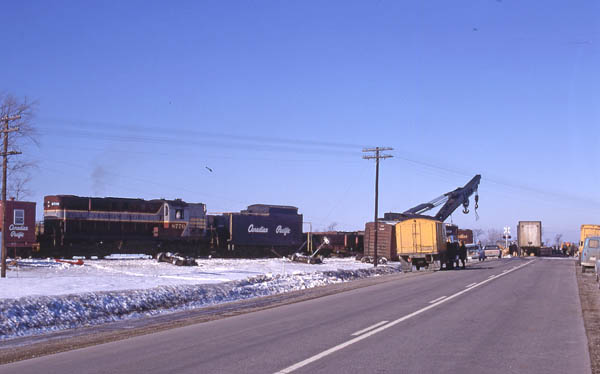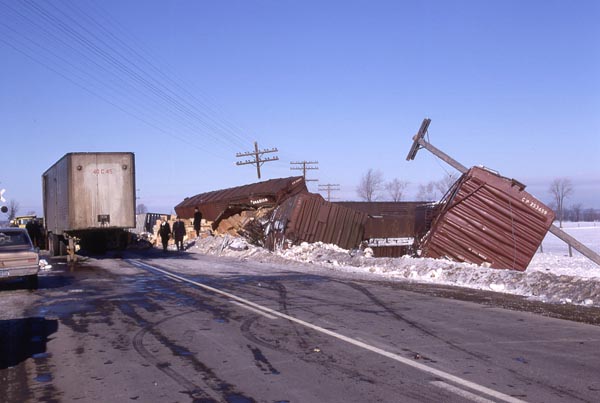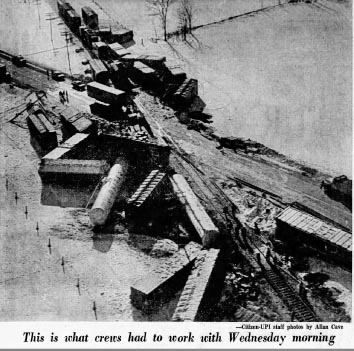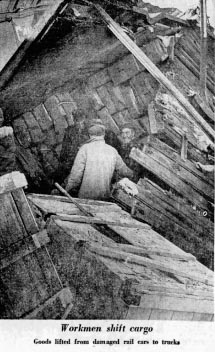Details of Railway Accidents in the Ottawa Area

1969, January 21 - 34 cars derailed between Carleton Place and Almonte, Canadian Pacific Chalk River subdivision.
This was caused by a broken wheel on the fifth car behind the locomotives.

| Ottawa Citizen 22 January 1969 Derailment (with aerial photo) CARLETON PLACE Attempts to clear the $500,000 wreckage of 34 freight cars piled up at a level crossing near here Tuesday continued this morning under the threat of an explosion from two overturned propane gas tankers. Provincial police kept guard over the area, about three miles north of here on Highway 29 at the CPR crossing, as about 50 men and two giant cranes hauled twisted box cars from the clogged line. The highway remained closed to traffic today while other trains were rerouted. The two tankers were not ruptured in the massive 3.30 p.m. derailment, but police kept hundreds of curious spectators well back from the scene in the event leaking gas might explode. Both police and railway officials were astonished that there had been no injuries. One of the first cars to derail left the tracks just before the level crossing and sliced across the highway only a few feet in front of a waiting school bus. Box cars stacked up Other cars ripped up sections of the highway, railway lines and wooden ties as they piled up, and in some cases, landed on top of one another. One freight car landed with its steel wheels on top of a tanker. Two hydro poles were sliced through by other cars. The top section of ome pole was left dangling over the line supported only by the high-voltage cables. Complete wheel assemblies of many cars were torn off as they piled into one another and lay strewn along the tracks among sections of line, twisted cars and splintered ties. Train Crash Theory - Wheel is Blamed A crack which caused the leading wheel of either the fourth or fifth car to come off is believed to be to blame for the $500,000 freight train crash near Carleton Place yesterday. It is known that at least eight rails between Almonte and the accident scene were broken. Faulty wheel likely This could have been caused by the faulty wheel running out of line and pounding against the rail as the east bound train headed for Carleton Place, said one railway employee. The 60-car freight train left Chalk River several hours before. Its speed at the time of the accident was estimated to be about 45 m.p.h. George G. Sayer, assistant superintendent for the Smiths Falls division of CPR, said work crews were concentrating their efforts to pulling cars away from the tracks and repairing breaks so regular traffic, which had been diverted to other lines, could again travel the main line. Mr. Sayer said he hoped the two cranes, one brought in from Smiths Falls and the other from Sudbury, could pull the two tankers back on to the tracks and pull them away by sometime this afternoon. "The line should be open again by about 5 p.m. today," he said, adding that the general freight being carried by the train could then be hauled away and the other cars righted and moved later this week. Mr. Sayer said there was, as far as he could tell, little damage to the cargo. One eye-witness, Bill Ritchie, 32, a Bell Telephone employee from Almonte, was driving north toward the level crossing when he saw the red signal lights begin flashing. "I saw the train swaying so I stopped about 500 feet from the tracks," he said. "The next thing I saw were freight cars flying through the air like cardboard boxes in a high wind. It was terrifying." He said a couple of cars shot across the highway "while the others piled up on the north side like magazines thrown on the floor." "There was a hell of a crash and snow flying in the air. A lot landed on my truck so I jumped out and after a minute or two ran up to the tracks. I thought people would be hurt," said Mr.Ritchie. He said that by the time he got there, people from the locomotive, that had shot through the crossing pulling three cars and dragging a fourth without wheels, met him. "One box car just missed the school bus, which luckily didn't have any children aboard, and another cut into the hydro poles and the warning flashers," said Mr. Richie. "There was a ball of fire in the sky when one hydro pole was cut off," said Mr. Ritchie, who added that he and a work-mate then flagged down cars until police arrived.  Bill Linley Photo  Bill Linley photo Ottawa Citizen 23 January 1969
CARLETON PLACE (Staff) Two huge cranes gently lowered a tank-car full of propane back on the track near here Wednesday afternoon and the Canadian Pacific's main line to Vancouver was open for business again. Twenty-four hours earlier 34 of 60 freight cars derailed when a wheel on one of the cars broke. No one was injured in the wreck which saw cars fly through the air like empty boxes. Though there were three tanks filled with propane, none of them ruptured or leaked. The train, under the control of conductor H. F. Row and engineer John Leach, both of Smiths Falls, piled up three miles north of here at 3.30 p.m. while travelling between Chalk River and Smiths Falls. A work crew of 75 men assisted by the two cranes, one from Sudbury and the other from Smiths Falls, and two bulldozers cleared away the wreckage and laid down about one-quarter mile of new track to replace that damaged in the $500,000 accident. At 5.30 p.m. Wednesday The Canadian, the railway's crack transcontinental passenger train, was the first train over the re-opened stretch of track. V. E. Everitt, superintendent of the Smiths Falls division of the CPR, said late Wednesday afternoon that it will be another 48 hours before Highway 29 will be open. Repair crews knocked off work Wednesday about 4 p.m. Many of the men had been working since the wreck occurred. The crews were back at the job early this morning to continue the cleanup. All day Wednesday men were busy transferring cargo from the battered box cars to trucks. Today the ticklish job of hauling the two remaining tank cars full of gas close enough to the tracks for the huge cranes to pick them up will begin. |

Return to Main Page of Railway Accidents
Updated 7 April 2020


